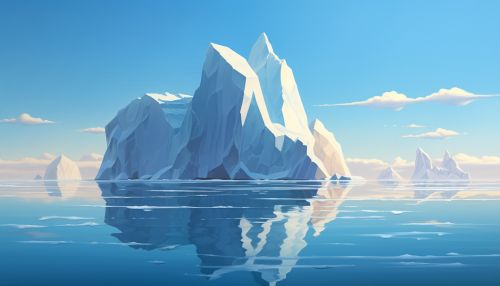Iceberg
Introduction
An Iceberg is a large piece of freshwater ice that has broken off a glacier or an ice shelf and is floating freely in open water. It may subsequently become frozen into pack ice (one form of sea ice). As it drifts into shallower waters, it may come into contact with the seabed, a process referred to as seabed gouging by ice.
Formation
Icebergs are formed from the breaking of glaciers, a process known as calving. This occurs when the glacier extends over the sea and breaks off due to the movement of the ice and the gravitational pull. The size of the iceberg formed depends on the size of the calving that occurs.


Structure
Icebergs are composed of freshwater ice, and contain a complex structure. They are not simply a solid block of ice, but rather contain crevasses, tunnels, and even lakes. The majority of an iceberg's mass is below the surface of the water, which led to the saying "the tip of the iceberg".
Types of Icebergs
There are several types of icebergs, classified by their shape. The two main types of icebergs are tabular and non-tabular. Tabular icebergs have steep sides and a flat top, while non-tabular icebergs include dome, pinnacle, wedge, and drydock.
Size and Scale
Icebergs vary greatly in size, from small bergs that are less than 1 meter (3.3 feet) across, to large ice islands that can be over 10 kilometers (6.2 miles) across. The largest recorded iceberg was Iceberg B-15, which broke off from the Ross Ice Shelf in Antarctica in 2000, and measured around 295 kilometers (183 miles) in length and 37 kilometers (23 miles) in width.
Iceberg Drift
Icebergs drift with ocean currents and winds. They can travel great distances from their place of origin, and can be found in the waters around Antarctica and the North Atlantic. The path of an iceberg, known as its drift track, can be tracked using satellites.
Impact on Marine Life
Icebergs play a significant role in the marine ecosystem. They serve as a habitat for a variety of marine life, including seals, penguins, and a variety of microorganisms. The melting of icebergs also contributes to the nutrient cycle in the ocean, as they release nutrients stored in the ice into the water.
Iceberg Monitoring and Research
Iceberg monitoring and research is important for understanding climate change and for maritime safety. Iceberg tracking is done using satellite imagery and radar, and research is conducted to study the rate of iceberg calving and melting, and the impact of icebergs on ocean circulation and marine life.
Icebergs and Climate Change
Icebergs are a key indicator of climate change. The rate of iceberg calving and melting can provide information about changes in ocean temperatures and currents. The study of icebergs is therefore crucial in understanding the impacts of climate change on the polar regions and the world's oceans.
